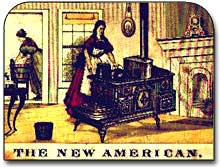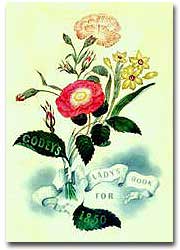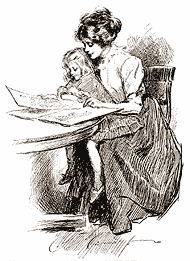25e. The Emergence of "Women's Sphere"

Chaos seemed to reign in the early 1800s. Cities swelled with immigrants and farmers' sons and daughters seeking their fortunes. Disease, poverty, and crime were rampant. Factory cities were being built almost overnight and the frontier was reaching to the Pacific Coast. The public institutions — schools, hospitals, orphanages, almshouses, and prisons — were expected to handle these problems, but were overwhelmed. Somewhere there must be safe haven from the hubbub and confusion of business and industry, a private refuge. That place was the home.
Money equaled status, and increased status opened more doors of opportunity for the upwardly mobile. The home was the perfect location to display the wealth. The husband had to be out in the public sphere creating the wealth, but his wife was free to manage the private sphere, the "women's sphere." Together, a successful husband and wife created a picture of perfect harmony. As he developed skills for business, she cultivated a complementary role. This recipe for success was so popular that all who could adopted it. In short order the newly created roles for men and women were thought to reflect their true nature. A true man was concerned about success and moving up the social ladder. He was aggressive, competitive, rational, and channeled all of his time and energy into his work. A true woman, on the other hand, was virtuous. Her four chief characteristics were piety, purity, submissiveness and domesticity. She was the great civilizer who created order in the home in return for her husband's protection, financial security and social status.

The Godey's Lady's book provided guidelines for the acceptable roles of a "proper" Victorian woman.
Women's virtue was as much a hallmark of Victorian society as materialism. As long as women functioned flawlessly within the domestic sphere and never ventured from it, women were held in reverence by their husbands and general society. But this was carried to ridiculous extremes. To protect women's purity, certain words could not be spoken in their presence. Undergarments were "unmentionables." A leg or an arm was called a "limb." Even tables had limbs, and in one especially delicate household, the "limbs" of a piano were covered in little trousers!
A Wife's Need (Godey's Lady's Book)
Without ignoring accomplishments, or casting a slur upon any of the graces which serve to adorn society, we must look deeper for the acquirements which serve to form our ideal of a perfect woman. The companion of man should be able thoroughly to sympathize with him — her intellect should be as well developed as his. We do not believe in the mental inequality of the sexes; we believe that the man and the woman have each a work to do, for which they are specially qualified, and in which they are called to excel. Though the work is not the same, it is equally noble, and demands an equal exercise of capacity.
From Godey's Lady's Book, Vol. LIII, July to December, 1856.
The cult of true womanhood was not simply fostered by men. In fact, the promotion of women's sphere was a female obsession as well. Writers like Sarah Hale published magazines that detailed the behaviors of a proper lady. Godey's Lady's Book sold 150,000 copies annually. Catherine Beecher advocated taking women's sphere to the classroom. Women as teachers, she said, could instill the proper moral code into future generations.

While women often stayed at home during the years preceding the Industrial Revolution, the advent of factories made many of her duties around the home obselete as manufactured products replaced goods produced in the home.
It was a fragile existence for a woman. One indiscretion, trivial by today's standards, would be her downfall, and there was no place in polite society for a fallen woman. But a fallen woman was not alone. The great majority of women never met the rigorous standard of "True Womanhood" set by the Victorian middle class, nor could they ever hope to. Sojourner Truth drove that point home in 1851. "That man over there says that women need to be helped into carriages, and lifted over ditches, and to have the best place everywhere. Nobody ever helps me into carriages, or over mud-puddles, or gives me any best place! And ain't I a woman?" Only white women of European descent, and very few of them, could be "True Women." For immigrant women, the wives and daughters of farmers, and the women who followed their husbands to the frontier, the necessities of daily life overshadowed the niceties. Nevertheless, the ideal of True Womanhood affected every facet of American culture in the 19th century.






